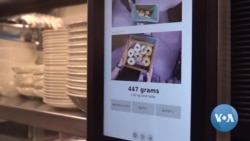ມີອາຫານຫລາຍເຖິງ 40 ເປີເຊັນທີ່ຜະລິດຢູ່ໃນສະຫະລັດທີ່ຄົນບໍ່ກິນໝົດ, ອີງຕາມສະພາປ້ອງກັນຊັບພະ ຍາກອນທໍາມະຊາດ. ສ່ວນໃຫຍ່ອາຫານເຫລົ່ານີ້ໃນທີ່ສຸດກໍຕົກໄປຢູ່ໃນລານຖິ້ມຂີ້ເຫຍື້ອ ບ່ອນທີ່ມັນປ່ອຍ ທາດເມຕານໃນປະລິມານອັນມະຫາສານອອກມາ.
ເພື່ອຊ່ວຍແກ້ໄຂບັນຫາລະດັບໂລກອັນນີ້, ບໍລິສັດເນເທີແລນແຫ່ງນຶ່ງ ໄດ້ພັດທະນາລະບົບການກວດສອບ ອາຫານເຫລືອທີ່ໃຊ້ປັນຍາປະດິດ ຫລື AI ເພື່ອຊ່ວຍໃຫ້ພໍ່ຄົວໃນຮ້ານອາຫານສາມາດກໍານົດ ແລະວັດແທກ ປະລິມານຂອງອາຫານທີ່ຖືກຖິ້ມ ຢູ່ໃນເຮືອນຄົວຂອງພວກເຂົາເຈົ້າໄດ້.
ທ່ານໂອລັຟ ແວນ ເດີ ວີນ (Olaf van der Veen) ແມ່ນຜູ້ໃນຄູ່ຮ່ວມລົງ ທຶນຂອງບໍລິສັດອໍບິສຄ໌ (Orbisk) 3 ທ່ານ.
ທ່ານໂອລັຟ ແວນ ເດີ ວີນ, ຫົວໜ້າຜູ້ບໍລິຫານ ຫລື CEO ຂອງບໍລິສັດ Orbisk ກ່າວວ່າ:
"ພວກເຮົາຈັດວາງຖັງຂີ້ເຫຍື້ອທີ່ມີຊິງຊັ່ງນໍ້າໜັກຢູ່ລຸ່ມ ແລະເອົາກ້ອງຖ່າຍຮູບ ຕິດໃສ່ຢູ່ເທິງ ແລະທຸກຄັ້ງ ທີ່ມີສິ່ງຂອງຖິ້ມລົງໄປ ພວກເຮົາຈະຖ່າຍຮູບເອົາ ແລະລະບົບການຮັບຮູ້ຮູບພາບ AI ຂອງພວກເຮົາຈະ ຈື່ປະເພດ ຂອງອາຫານທີ່ຖອກຖິ້ມນັ້ນ."
ຂໍ້ມູນດັ່ງກ່າວໄດ້ຖືກເກັບກໍາໃນທັນທີທັນໃດ ແລະເອົາໃຫ້ເບິ່ງຢູ່ເທິງກະດານ… …ເພື່ອຊ່ວຍໃຫ້ພໍ່ຄົວເຫັນ ບັນຫາ ທີ່ມັກເກີດຂຶ້ນຢູ່ຕະຫລອດ.
ທ່ານແວນ ເດີ ວີນ, CEO ຂອງ Orbisk ກ່າວອີກວ່າ:
“ເຊັ່ນວ່າ ເຈົ້າເອົາໝາກເລັ່ນຖິ້ມ 10 ກິໂລ ທຸກໆ ເຊົ້າວັນອັງຄານ, ນັ້ນແມ່ນ ສິ່ງທີ່ພວກເຮົາຈະບອກໃຫ້ທ່ານຮູ້. ສົມມຸດວ່າ ສະຫຼັດບຸບເຟ້ຂອງທ່ານບໍ່ຄ່ອຍມີຄົນມັກປານໃດໃນມື້ວັນສຸກ ເພາະວ່າຜູ້ຄົນຢາກກິນ ອາຫານ ທີ່ກິນສະດວກສະ ບາຍຫຼາຍກວ່າ ແລະເພາະສະນັ້ນ ທ່ານຈະເອົາມັນຖິ້ມເປັນສ່ວນຫຼາຍ.”
ນັ້ນແມ່ນປະເພດຂອງຄວາມເຂົ້າໃຈ ທີ່ພໍ່ຄົວໃນປັດຈຸບັນ ສາມາດເຂົ້າເຖິງໄດ້ ເພື່ອຜັກດັນໃຫ້ສິ່ງເສດເຫຼືອ ຂອງເຂົາເຈົ້າຫລຸດລົງ, ປັບປຸງຄວາມຍືນຍົງ ຂອງເຂົາເຈົ້າ - ແລະມີກໍາໄລ.
ທ່ານແວນ ເດີ ວີນ ກ່າວຕໍ່ໄປວ່າ:
"ບໍ່ມີພໍ່ຄົວຄົນໃດໃນໂລກ ທີ່ມັກແຕ່ງອາຫານເພື່ອໃຫ້ໂຍນລົງຖັງຂີ້ເຫຍື້ອ."
ທ່ານນາງວອນນີ ແອສເທສ (Vonnie Estes) ເປັນຮອງປະທານຝ່າຍ ປະດິດສ້າງຂອງສະມາຄົມຜະລິດ ຕະພັນສົດສາກົນ. ທ່ານນາງເວົ້າກັບວີໂອເອ ຜ່ານທາງ Skype ວ່າ:
"ດັ່ງນັ້ນ ສິ່ງທີ່ເທັກໂນໂລຈີຂອງພວກເຂົາເຈົ້າ ສາມາດເຮັດໄດ້ຈາກທັດສະນະ ຂອງຮ້ານອາຫານແລ້ວ ແມ່ນເຮັດໃຫ້ເຂົາເຈົ້າສາມາດຄາດຄະເນແລະເຮັດອາ ຫານໃນປະລິມານທີ່ເຫມາະສົມໄດ້ ໂດຍຜ່ານ ປັນຍາປະດິດ."
ຮ້ານອາຫານບໍ່ຕ້ອງຊື້ເຄື່ອງຈັກ ແຕ່ຕ້ອງເສຍຄ່າທໍານຽມປະຈໍາເດືອນສໍາລັບ ຂໍ້ມູນທີ່ເຄື່ອງຈັກເກັບກໍາ ແລະແບ່ງປັນໃຫ້ຮູ້.
ບໍລິສັດກ່າວວ່າ ນັບຕັ້ງແຕ່ມັນເລີ້ມເປີດຕົວໃນປີ 2019 ເປັນຕົ້ນມາ ການບໍລິ ການດັ່ງກ່າວໄດ້ຊ່ວຍໃຫ້ຮ້ານ ອາຫານປະມານ 100 ແຫ່ງໃນຢູໂຣບປະຢັດ ອາຫານເສດເຫລືອ ... ແລະເງິນໄດ້.
ທ່ານແວນ ເດີ ວີນ ກ່າວມ້ວນທ້າຍວ່າ:
"ເທົ່າທີ່ຜ່ານມາ, ພວກເຮົາປະຢັດອາຫານໄດ້ປະມານ 200,000 ຫາ 300,000 ກິໂລ ແລະມີມູນຄ່າປະ ມານ 1.2 ລ້ານ ຫາ 1.8 ລ້ານໂດລາ."
ບໍລິສັດວາງແຜນທີ່ຈະຂະຫຍາຍມາສູ່ຕະຫຼາດຕ່າງໆ ໃນສະຫະລັດ ແລະຫວັງວ່າ ມື້ນຶ່ງຈະກໍາຈັດອາຫານ ເສດເຫລືອ ບໍ່ໃຫ້ມີຢູ່ໃນເຮືອນຄົວອຸດສາຫະກໍາທັງ ຫມົດເລີຍ.
ອ່ານລາຍງານນີ້ເພີ້ມເປັນພາສາອັງກິດຢູ່ຂ້າງລຸ່ມນີ້:
Up to 40% of food in the U.S. is discarded. But as VOA’s Julie Taboh reports, a company in the Netherlands has come up with technology that can help reduce food waste in industrial kitchens.
As much as 40% of food produced in the U.S. goes uneaten, according to the Natural Resources Defense Council.
Most of it ends up in landfills, where it releases massive amounts of methane.
To help address this global problem, a Dutch company has developed a food waste monitoring system that uses artificial intelligence to help restaurant chefs identify and measure the amount of food being discarded in their kitchens.
Olaf der Veen is one of three partners at Orbisk. He said:
“We outfit the waste bin with a weighing scale underneath and a camera unit on top and every time something is disposed of, we take a picture, and our AI image recognition algorithms recognize the type of food that's being thrown away.”
The data is instantly collected and shared on a dashboard… …to help chefs see any recurring issues.
Olaf van der Veen, Orbisk CEO: “Say you waste 10 kilos of tomatoes every Tuesday morning, that's what we'll tell you. Say your salad buffet doesn't work very well on Fridays because people are more craving for comfort foods, and thus you throw away a lot of it.”
That’s the kind of insights chefs can now access to drive down their waste, improve their sustainability – and profitability.
Olaf van der Veen: “There's not a chef in the world that likes to cook for the waste bin.”
Vonnie Estes is vice president of innovation for the International Fresh Produce Association. She spoke with VOA via Skype: “So what their technology is able to do from a restauranteur’s point of view is really allow them, through artificial intelligence, to predict and to make the right amount of food.”
Restaurants don’t buy the machine but pay a monthly subscription fee for the information the machine collects and shares.
Since it launched in 2019, the service has helped about 100 restaurants in Europe save food waste … and money, the company says.
Olaf van der Veen: “We’ve saved about 200,000 to 300,000 kilos to date and that has a value of about $1.2 to $1.8 million dollars so far.”
The company plans to expand to markets in the U.S. and hopes one day to eliminate food waste altogether from industrial kitchens.





